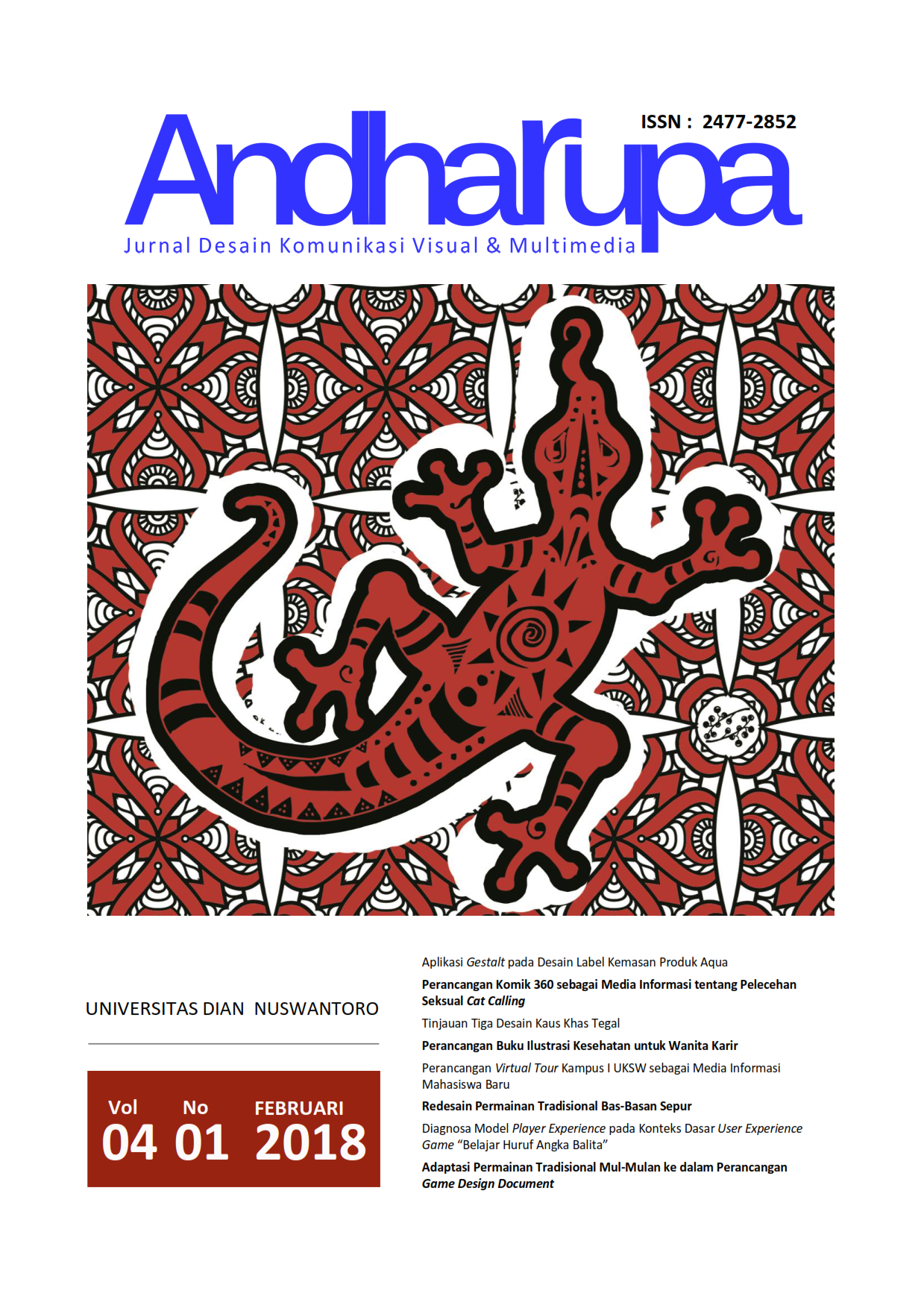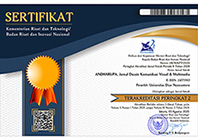Adaptasi Permainan Tradisional Mul-Mulan ke dalam Perancangan Game Design Document
DOI:
https://doi.org/10.33633/andharupa.v4i01.1588Abstract
AbstrakSeperti halnya keberadaan permainan tradisional pada umumnya, Mul-mulan memiliki masalah yang sama yaitu telah tergeser oleh jenis permainan digital saat ini. Upaya membawa permainan Mul-mulan ke dalam permainan digital menjadi sangat memungkinkan melihat daya tarik dan kecepatan informasi yang diberikan teknologi digital. Sehingga dengan memanfaatkan daya tarik teknologi digital tersebut, permainan Mul-mulan dapat menjadi konten baru permainan digital yang dapat menambah daya tarik penggunanya. Penelitian ini menggunakan metode ATUMICS untuk menganalisis elemen budaya permainan tradisional Mul-mulan. Selanjutnya elemen-elemen tersebut dipadukan dengan struktur permainan digital yang baik dan menyenangkan. Hasilnya adalah konsep perancangan permainan digital yang mengandung unsur fun dan unsur budaya yang seimbang yang disusun dalam dokumen perancangan desain game digital. Melalui penelitian ini terwujud sebuah rancangan model permainan digital baru dalam bentuk Game Design Document (GDD) yang menarik dan tetap mempertahankan nilai budaya permainan Mul-mulan di dalamnya.  Kata kunci: adaptasi, game, GDD, mul-mulan, permainan tradisional  AbstractLike the existence of traditional games, Mul-mulan has the same problem that has been displaced by the digital games today. The effort to bring Mul-mulan into digital game becomes very possible by looking at the attractiveness and the speed of information provided by digital technology. So by using that, Mul-mulan can be a new content of digital games that can add the appeal to its users. This research uses ATUMICS method to analyze traditional culture element of Mul-mulan game. Then the elements are combined with a good and fun digital game structure. The result is the concept of designing digital games that contain elements of fun and cultural elements. Through this research obtained the model of new digital game in form Game Design Document (GDD) which interesting and maintain the cultural value of Mul-mulan. Keywords: adaptation, games, GDD, mul-mulan, traditional gamesReferences
Adams, E. (2010). Fundamentals of Game Design 2nd ed. Berkeley: New Riders.
Dharmamulja, S. (2005). Permainan Tradisional Jawa. Yogyakarta: Kepel Press.
Fullerton, T. et all. (2013). Game Design Workshop : a Playcentric Approach to Creating Innovative Games, Third Edition. Burlington: CRC Press.
Handayani, P. P., M.Suyanto, & Al Fatta, H. (2015). Perancangan Game Design Document Serious Game Permainan Tradisional Angklek Sleman Yogyakarta. Seminar Nasional Informatika 2015, 1, 1–7.
Khamadi, K., & Senoprabowo, A. (2017). Adaptasi Permainan Papan Tradisional ke dalam Permainan Digital dengan Pendekatan Atumics: Studi Kasus Permainan Mul-Mulan. In Seminar Nasional Seni dan Desain 2017 (Vol. 2, pp. 386–393). Surabaya: State University of Surabaya.
Khamadi & Senoprabowo, A. (2016). Model Adaptasi Permainan Papan Tradisional Macanan Ke Dalam Perancangan Permainan Digital. Andharupa, Jurnal Desain Komunikasi Visual & Multimedia, 2(2), 167–180.
Nugraha, A. (2012). Transforming Tradition : a Method for Maintaining Tradition in a Craft and Design Context. Helsinki: Aalto University, School of Arts, Design and Architecture.
Pulsipher, L. (2012). Game Design : How to Create Video and Tabletop Games, Start to Finish. McFarland & Company, Inc., Publishers.
Downloads
Published
Issue
Section
License
Copyright (c) 2018 ANDHARUPA: Jurnal Desain Komunikasi Visual & Multimedia

This work is licensed under a Creative Commons Attribution 4.0 International License.
Authors who publish with this journal agree to the following terms:
- Authors retain copyright and grant the journal right of first publication with the work simultaneously licensed under a Creative Commons Attribution License that allows others to share the work with an acknowledgment of the work's authorship and initial publication in this journal.
- Authors are able to enter into separate, additional contractual arrangements for the non-exclusive distribution of the journal's published version of the work (e.g., post it to an institutional repository or publish it in a book), with an acknowledgment of its initial publication in this journal.
- Authors are permitted and encouraged to post their work online (e.g., in institutional repositories or on their website) prior to and during the submission process, as it can lead to productive exchanges, as well as earlier and greater citation of published work (See The Effect of Open Access).















